Retaining Walls
NJ Installations
Keystone Retaining Wall
installations
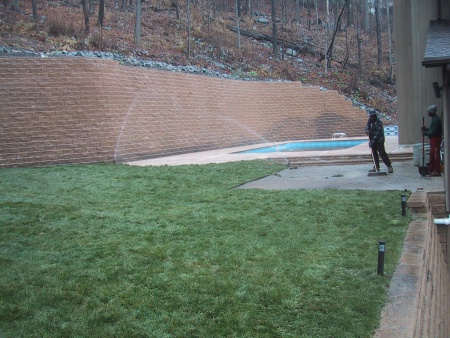 Keystone retaining walls are an excellent choice for a home that needs excavation and load bearing retaining walls. The Keystone system is engineered to withstand the test of time. This home required major excavation to accommodate a swimming pool in the rear yard which backed up to a steep slope. An application such as this requires plenty of excavation and drainage for the retaining wall system. Bobcats for Hire utilizes an automated process when building a Keystone wall. This helps to save on labor and ensures that the correct amount of stone is always used in the backfill of the installation. Stone is used for drainage to prevent water from adding to the weight of the soil behind the wall and preventing lateral forces from leading to wall failure. Drainage is very important on any retaining wall system, and especially important as the wall height rises above three feet. An adequate drainage system will ensure that your retaining wall will last for future generations to come.
Keystone retaining walls are an excellent choice for a home that needs excavation and load bearing retaining walls. The Keystone system is engineered to withstand the test of time. This home required major excavation to accommodate a swimming pool in the rear yard which backed up to a steep slope. An application such as this requires plenty of excavation and drainage for the retaining wall system. Bobcats for Hire utilizes an automated process when building a Keystone wall. This helps to save on labor and ensures that the correct amount of stone is always used in the backfill of the installation. Stone is used for drainage to prevent water from adding to the weight of the soil behind the wall and preventing lateral forces from leading to wall failure. Drainage is very important on any retaining wall system, and especially important as the wall height rises above three feet. An adequate drainage system will ensure that your retaining wall will last for future generations to come.
Steep slope retaining wall
and drainage
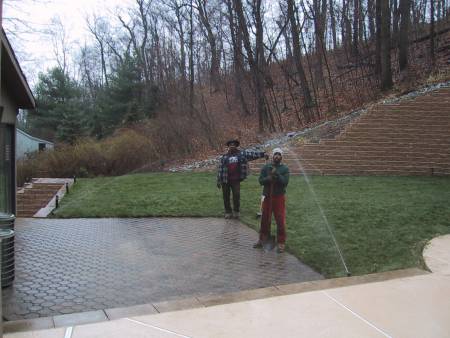 At this steep slope site, many contractors told the homeowner that this patio installation could not be installed due to the retaining wall configuration and difficult access leading into the rear yard. Our track loaders and owner-operator nature of our business made this project possible which also included the sprinkler system, drainage, and sod as well. If your property requires retaining walls and drainage work, call today to see the possibilities to make your property the best it can be!!!
At this steep slope site, many contractors told the homeowner that this patio installation could not be installed due to the retaining wall configuration and difficult access leading into the rear yard. Our track loaders and owner-operator nature of our business made this project possible which also included the sprinkler system, drainage, and sod as well. If your property requires retaining walls and drainage work, call today to see the possibilities to make your property the best it can be!!!
Ledge rock demolition and
Retaining Wall installation
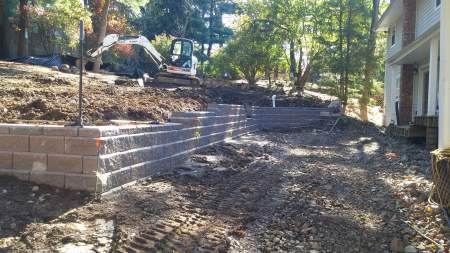 Digging into a slope to provide more level land alters the course of the underground water flow. By designing an appropriate drainage system for a retaining wall, one can be assured that their new landscape and level area will in fact be usable following the construction of the retaining wall. All too often, drainage is an afterthought and results in a finished project that looks like this one (right and below). This wall had been built by a hack and did not incorporate the necessary drainage system behind the wall to prevent damaging ground saturation to the lawn areas. Of course it is much more work to install the correct drainage system after the wall is built, but in this case, that is what needed to be done. Be smart and insist that adequate drainage is designed for your project at the planning stages of your project. This is the time that it is least expensive to install. Installation of this system after the wall is built involves more work and cost that can easily be avoided with proper planning.
Digging into a slope to provide more level land alters the course of the underground water flow. By designing an appropriate drainage system for a retaining wall, one can be assured that their new landscape and level area will in fact be usable following the construction of the retaining wall. All too often, drainage is an afterthought and results in a finished project that looks like this one (right and below). This wall had been built by a hack and did not incorporate the necessary drainage system behind the wall to prevent damaging ground saturation to the lawn areas. Of course it is much more work to install the correct drainage system after the wall is built, but in this case, that is what needed to be done. Be smart and insist that adequate drainage is designed for your project at the planning stages of your project. This is the time that it is least expensive to install. Installation of this system after the wall is built involves more work and cost that can easily be avoided with proper planning.
Stone Face
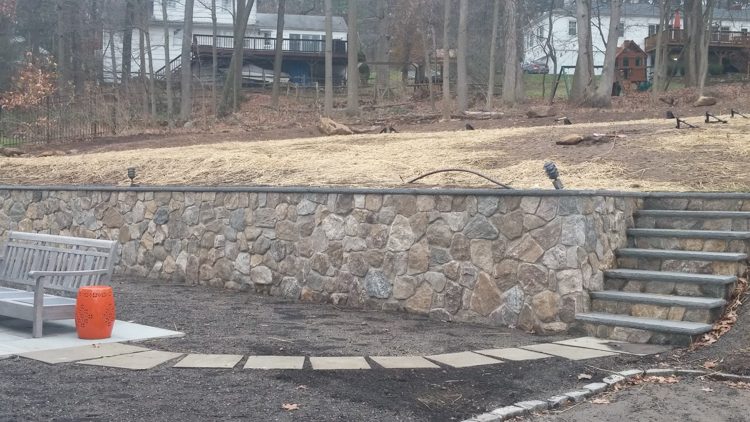 Refacing an older retaining wall may be possible as part of your overall backyard plan. This is an example of a brick wall being refaced with real stone to totally change out the appearance of the backyard at this house. Before photo is below.
Refacing an older retaining wall may be possible as part of your overall backyard plan. This is an example of a brick wall being refaced with real stone to totally change out the appearance of the backyard at this house. Before photo is below.
Before Stone Face
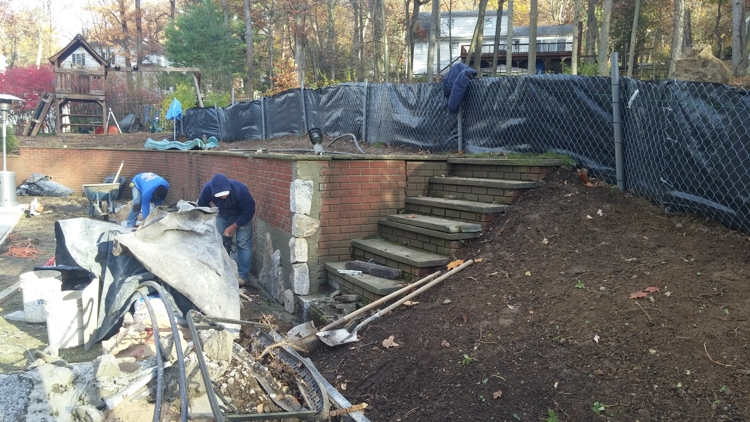 Refacing an older retaining wall may be possible. This is the photo of the original older, brick wall.
Refacing an older retaining wall may be possible. This is the photo of the original older, brick wall.
Poorly constructed Retaining walls
lack proper drainage
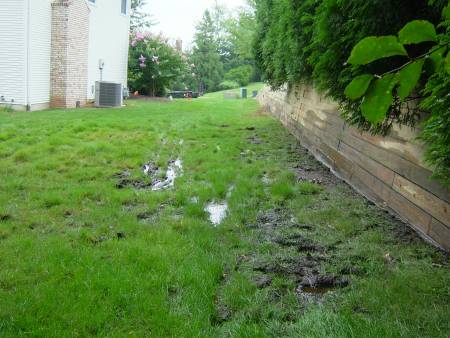 These homes have had poorly constructed retaining walls installed by low bid landscapers. A wall of this height should have stone backfill and proper drainage to accommodate the seeping water. Allowing water to accumulate behind the wall will increase lateral pressure over time until the wall fails. Another example of a failed wall looks like this. At this home, the landscaper dug out portions of the rear yard and installed this wall. There was no drainage installed to accommodate the seeping water from the very long hill to the rear of the property. Lateral pressure is continuously forcing the retaining wall to move forwards, and is most noticeable in the areas where the wall is curving. Over time, this wall will fail and need to be replaced.
These homes have had poorly constructed retaining walls installed by low bid landscapers. A wall of this height should have stone backfill and proper drainage to accommodate the seeping water. Allowing water to accumulate behind the wall will increase lateral pressure over time until the wall fails. Another example of a failed wall looks like this. At this home, the landscaper dug out portions of the rear yard and installed this wall. There was no drainage installed to accommodate the seeping water from the very long hill to the rear of the property. Lateral pressure is continuously forcing the retaining wall to move forwards, and is most noticeable in the areas where the wall is curving. Over time, this wall will fail and need to be replaced.Retaining walls require drainage
Retaining walls Require adequate drainage behind the wall to function properly for the long haul.Digging into a slope to provide more level land alters the course of the underground water flow. By designing an appropriate drainage system for a retaining wall, one can be assured that their new landscape and level area will in fact be usable following the construction of the retaining wall. All too often, drainage is an afterthought and results in a finished project that looks like this one pictured to the left. This wall had been built by a hack and did not incorporate the necessary drainage system behind the wall to prevent damaging ground saturation to the lawn areas. It is much more work to install the correct drainage system after the wall is built, but in this case, that is what needed to be done. Be smart and insist that adequate drainage is designed for your project at the planning stages of your project. This is the time that it is least expensive to install. Installation of a drainage system after the wall is built involves much more work and cost that can easily be avoided with proper planning at the beginning of the project.
A retaining Wall can add Valuable Land to your home and make it much more functional.